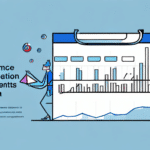How to Measure Your Customer Retention Rate KPI
As a business owner, you understand that customers are the backbone of your enterprise. Without them, your business simply would not exist. Keeping them happy and engaged is crucial for sustained success. Measuring your customer retention rate is a key strategy to achieve this. In this article, we’ll explore what customer retention rate is, why it’s important, how to measure it, and strategies to improve it.
Why Measuring Customer Retention Rate is Vital for Your Business
Customer retention rate (CRR) measures the percentage of customers who continue to use your product or service over a specific period. According to a Bain & Company report, increasing customer retention by just 5% can boost profits by 25% to 95%. A high retention rate indicates that customers are satisfied and loyal, while a low rate signals potential issues with your offerings or customer engagement strategies.
Measuring CRR helps identify areas for improvement. By analyzing why customers leave, you can make informed changes to enhance your product or service, thereby increasing customer satisfaction and loyalty. This not only leads to higher profits but also reduces the costs associated with acquiring new customers.
Additionally, CRR data can inform strategic decisions such as product development, marketing strategies, and customer service enhancements. For instance, a high retention rate may suggest strong product-market fit, while a declining rate might indicate the need for innovation or improved customer support.
The Fundamentals of Customer Retention Rate
Calculating your customer retention rate involves the following steps:
- Define the Time Period: Determine the period over which you want to measure retention (e.g., monthly, quarterly, annually).
- Identify the Number of Customers at the Start: Count the number of customers at the beginning of the period.
- Identify the Number of Customers at the End: Count the number of customers at the end of the period.
- Determine the Number of Customers Who Stayed: Subtract any new customers acquired during the period from the end count.
- Apply the Formula:
CRR = [(Customers at End - New Customers) / Customers at Start] × 100
For example, if you had 200 customers at the beginning of the year, acquired 50 new customers, and ended the year with 220 customers, your retention rate would be:
CRR = [(220 - 50) / 200] × 100 = 85%
A high CRR signifies strong customer loyalty and satisfaction, while a low CRR may indicate underlying problems that need addressing.
What Your Customer Retention Rate Reveals About Your Business
Your CRR provides insights into customer satisfaction, product quality, and the effectiveness of your customer service. A consistently high retention rate suggests that your business successfully meets customer needs and expectations. Conversely, a declining retention rate can highlight issues such as poor customer service, subpar product quality, or ineffective engagement strategies.
High retention rates contribute to increased revenue through repeat purchases and positive word-of-mouth referrals. According to a Harvard Business Review study, increasing customer retention by 5% can lead to a profit increase of between 25% and 95%. Therefore, focusing on retention is not only cost-effective but also a significant driver of profitability.
Understanding the Relationship Between Customer Retention and Customer Loyalty
While customer retention and customer loyalty are interconnected, they are not synonymous. Customer retention focuses on the ability to keep customers over time, whereas customer loyalty emphasizes the emotional and psychological connection a customer has with your brand.
Loyal customers are more likely to provide repeat business, advocate for your brand, and be less price-sensitive. Building loyalty involves creating meaningful interactions, delivering consistent value, and fostering a sense of community around your brand.
Both retention and loyalty are essential. Retention ensures a steady revenue stream, while loyalty drives long-term growth through customer advocacy and sustained engagement.
Key Metrics to Monitor Alongside Your Customer Retention Rate
In addition to CRR, several other metrics provide a comprehensive view of your customer relationships:
- Customer Acquisition Cost (CAC): The cost associated with acquiring a new customer.
- Customer Lifetime Value (CLV): The total revenue a business can expect from a single customer account.
- Churn Rate: The percentage of customers who stop using your product or service during a given period.
- Net Promoter Score (NPS): Measures customer satisfaction and loyalty by asking how likely customers are to recommend your business.
Monitoring these metrics alongside CRR helps identify trends, evaluate the effectiveness of retention strategies, and make data-driven decisions to enhance overall customer experience.
The Impact of Customer Service on Your Retention Rate
Exceptional customer service is a critical factor influencing CRR. According to a Forbes article, 76% of customers consider customer service a key factor in their loyalty to a brand.
Poor customer service can lead to increased churn, negative reviews, and diminished brand reputation. On the other hand, proactive and personalized customer service fosters trust, encourages repeat business, and enhances overall customer satisfaction.
Investing in training your customer service team, implementing efficient support systems, and actively seeking customer feedback are effective strategies to improve service quality and, consequently, your retention rate.
Strategies to Improve Your Customer Retention Rate
Improving CRR involves a multifaceted approach focusing on customer satisfaction, engagement, and value delivery. Here are some effective strategies:
- Enhance Customer Experience: Streamline the customer journey by simplifying processes, reducing friction points, and ensuring consistent service quality.
- Implement Loyalty Programs: Reward repeat customers with discounts, exclusive offers, or early access to new products to incentivize continued business.
- Personalize Interactions: Use customer data to tailor communications, recommendations, and offers to individual preferences and behaviors.
- Regularly Solicit Feedback: Actively seek and act upon customer feedback to address concerns and improve your offerings.
- Engage Through Multiple Channels: Maintain active presence on various platforms (social media, email, etc.) to engage with customers where they are most active.
Implementing these strategies can lead to higher customer satisfaction, increased loyalty, and improved retention rates.
Best Practices for Tracking and Analyzing Your Retention KPIs
Effective tracking and analysis of retention KPIs require a systematic approach:
- Use Reliable Tools: Invest in Customer Relationship Management (CRM) systems like Salesforce or HubSpot CRM to accurately track customer interactions and metrics.
- Set Clear Objectives: Define what you aim to achieve with your retention strategies, such as reducing churn by a specific percentage.
- Segment Your Customers: Analyze retention rates across different customer segments to identify specific needs and tailor your approaches accordingly.
- Regular Reporting: Establish a routine for generating and reviewing retention reports to stay informed about trends and outcomes.
- Analyze and Act: Use the data to identify patterns, understand the root causes of churn, and implement targeted actions to address these issues.
Adhering to these best practices ensures that your retention efforts are data-driven and aligned with your business objectives.
Real-Life Examples of Companies with High and Low Customer Retention Rates
Understanding how leading companies manage retention can provide valuable insights:
- Amazon: With a retention rate exceeding 90%, Amazon excels through its customer-centric approach, vast product selection, and reliable customer service.
- Sears: Once a retail giant, Sears has struggled with a retention rate below 30%, largely due to declining customer service and failure to adapt to e-commerce trends.
- Netflix: Boasting a retention rate of over 80%, Netflix continuously invests in content personalization and user experience to keep subscribers engaged.
- Grooveshark: After numerous service issues and competition, Grooveshark saw its retention rate plummet, leading to its eventual shutdown.
These examples illustrate the critical role of customer retention strategies in a company's long-term success.
How to Use Your Customer Retention Data to Inform Business Decisions
CRR data is a powerful tool for strategic decision-making:
- Product Development: Insights into why customers stay or leave can guide the enhancement of existing products or the development of new ones.
- Marketing Strategies: Understanding which channels retain customers can help allocate marketing resources more effectively.
- Customer Service Improvements: Identifying common service issues allows for targeted training and process improvements.
- Pricing Strategies: Analyzing retention in relation to pricing can inform adjustments to maximize both retention and profitability.
By leveraging CRR data, businesses can make informed decisions that enhance customer satisfaction and drive growth.
Common Mistakes to Avoid When Measuring and Tracking Your Retention KPIs
Accurate measurement of retention KPIs is essential. Avoid these common pitfalls:
- Not Defining a Clear Time Frame: Without a specific period, comparisons and trend analysis become meaningless.
- Ignoring New Customers: Including new customers acquired during the period can skew retention metrics. Ensure you account for this in your calculations.
- Failing to Segment Customers: Treating all customers the same ignores the diverse behaviors and needs of different segments.
- Overlooking External Factors: Economic conditions, market trends, and competitive actions can impact retention and should be considered in your analysis.
- Neglecting Data Accuracy: Incomplete or incorrect data can lead to misleading conclusions. Ensure data integrity by regularly auditing your tracking systems.
By recognizing and avoiding these mistakes, you can ensure that your retention metrics are accurate and actionable.
Setting Goals and Targets for Improving Your Retention Rate
Establishing clear goals is essential for enhancing CRR:
- Establish a Baseline: Determine your current retention rate to understand where you stand.
- Set SMART Goals: Define Specific, Measurable, Achievable, Relevant, and Time-bound objectives. For example, aim to increase CRR by 5% over the next year.
- Develop a Strategic Plan: Outline the initiatives and strategies that will help achieve your retention goals, such as improving customer service or launching a loyalty program.
- Monitor Progress: Regularly track your retention metrics to assess progress toward your goals and make necessary adjustments.
- Celebrate Milestones: Acknowledge and reward progress to maintain motivation and commitment across your team.
Setting and following through with well-defined goals ensures focused efforts and measurable improvements in your retention rate.
Tools and Resources for Measuring and Analyzing Your Customer Retention KPIs
Several tools can assist in tracking and analyzing CRR:
- Customer Relationship Management (CRM) Systems: Tools like Salesforce and HubSpot CRM help manage customer data and track retention metrics.
- Analytics Platforms: Google Analytics provides insights into customer behavior and retention trends.
- Survey Tools: Platforms like SurveyMonkey and Typeform facilitate collecting customer feedback.
- Business Intelligence Tools: Solutions such as Microsoft Power BI and Tableau enable in-depth data analysis and visualization.
Leveraging these tools can enhance your ability to accurately track, analyze, and act upon your customer retention metrics.
Measuring customer retention rate is crucial for any business aiming for long-term success. By understanding its importance, accurately measuring it, and implementing effective strategies to improve it, you can foster customer loyalty, boost profitability, and ensure sustainable growth. Utilize the insights and best practices outlined in this article to enhance your retention efforts and drive your business forward.






















